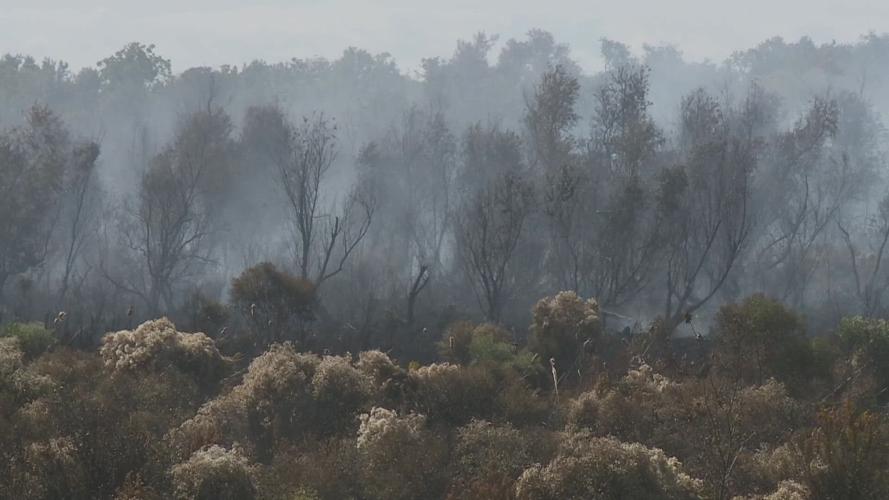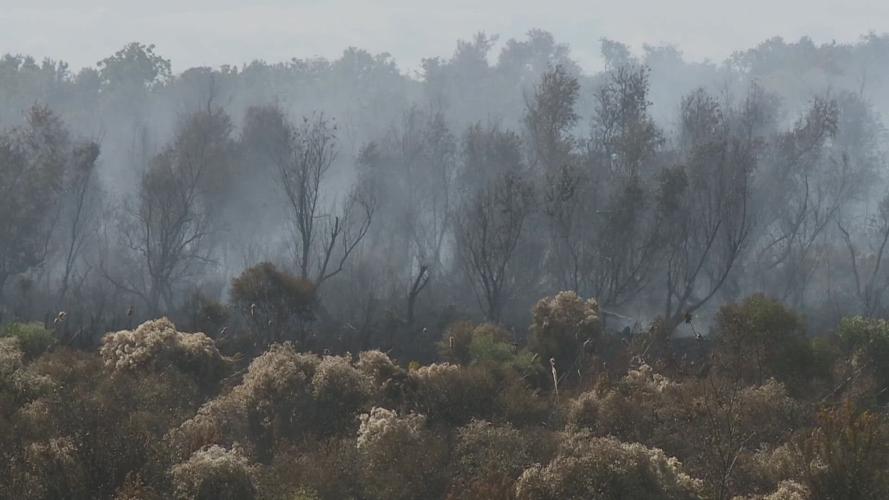Two long-running swamp fires in the New Orleans area have stopped spreading, but the thick, sometimes noxious smoke they produce may persist until a heavy rain soaks the region.
The necessary cloudbursts, however, aren’t in the forecast. No rain is predicted for at least a week.
In the meantime, crews battling the fire in Jean Lafitte say they’ll change tactics, putting shovels to work on patches of smoldering soil on a National Park Service property in the middle of the Jefferson Parish town.
The park service and crews from local fire departments have dropped water from helicopters and used bulldozers to cut lines that have halted the fire’s spread. Now they’ll focus on using hand tools to dig up hot soil and expose it to the air and nighttime humidity. They’ll also try dousing the churned soil with sprinklers during the night.

A helicopter hovers over a burned wetland in Jean Lafitte, Louisiana on Oct. 25, 2023.
“We have several hot spots that are smoldering in place and not growing,” said Meredith Hardy, a manager with the Jean Lafitte National Historical Park, which oversees several national park properties around New Orleans. “Some of those areas are a little tricky to get into.”
Smoke from both fires is believed to have combined with fog on Monday to create a "super fog" that resulted in a 158-vehicle pile-up on Interstate 55 in Manchac that left at least seven people dead and dozens injured.
The smoke has also closed down schools, irritated people’s eyes and lungs, and made driving difficult across the area.
As of Thursday morning, the Jean Lafitte fire had burned nearly 150 acres of mostly cypress-covered swamp and was about 52% contained.

An area marked in pink shows the National Park Service-owned swampland burned by an October 2023 wildfire in the town of Jean Lafitte, Louisiana.
The park service had previously said the blaze was in Barataria Preserve, a 26,000-acre swampland between Westwego and Jean Lafitte, but the fire is actually in a separate park service-owned property tucked into a corner of Jean Lafitte. The property was acquired by the park service in 2018, and has no trails or other public amenities. The burned area borders the town’s Wetland Trace parkland and is a quarter mile from Leo E. Kerner, Jr. Elementary School.
Meanwhile, the nearly two-week-long swamp fire in New Orleans East continues to cast smoke over the city, and will likely persist for days or maybe weeks. Efforts to flood the burned area appear to have weakened the fire, which has moved across private property between the Bayou Sauvage Urban National Wildlife Refuge and the Michoud Canal.
The New Orleans Sewerage & Water Board started pumping water from a drainage canal into the fire zone last week.
“The water level is up significantly, and that’s likely helping,” Bayou Sauvage manager Pon Dixson said Thursday. “But it was very smoky yesterday, and the smell was very strong.”

Patches of trees and brush stand in a burned wetland in Jean Lafitte, LA on Oct. 25, 2023.
Winds were lighter than on Wednesday, and much of the smoke early Thursday was traveling up rather than over populated areas.
The New Orleans East fire bored underground earlier than the Jean Lafitte fire, reaching a dense layer of peat, a flammable organic material that is very difficult to extinguish. Unlike an above-ground wetland fire, which burns grass and trees and sometimes has a sweet, earthy aroma, peat fires tend to smell like chemicals. They can also cause a host of health problems, leading to reports in the New Orleans area of eye and nose irritation, nausea and respiratory issues.
The New Orleans Fire Department has been mostly hands-off in regards to the blaze, saying the roadless, tree-covered area can’t be accessed by their firefighters and equipment. Dixson and other Bayou Sauvage staff convinced the Sewerage & Water Board to try pumping water into the fire zone last week.
Dixson expects the fire to hold steady, with air quality in populated areas worsening or improving depending on the direction and speed of the wind.
“This could go on for quite some time unless we get some significant rainfall,” he said.















